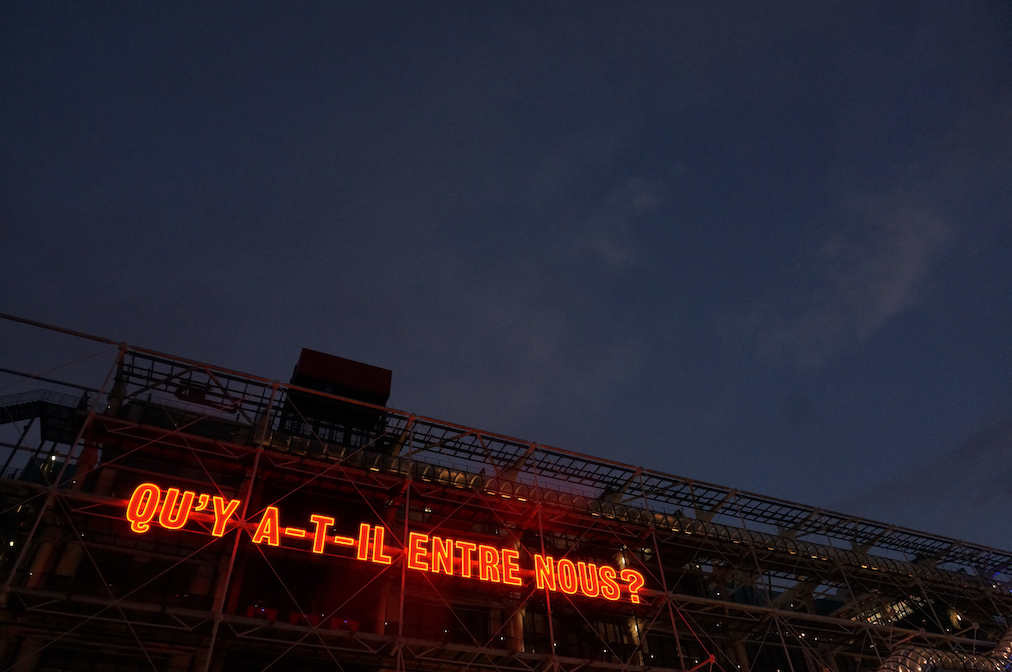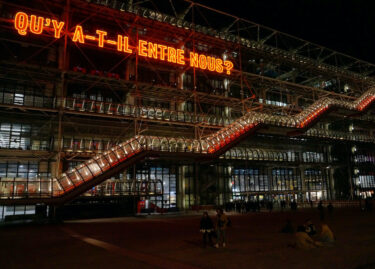
Interview with Tim Etchells about Qu’y a-t-il neon for Centre Pompidou
Could you tell us a bit more about the project you are presenting at Centre Pompidou ?
It’s a new work, commissioned especially for Pompidou. The full phrase is “Qu’y-at-il entre nous?” The letters are made of neon – in classic neon red, and they’re backed with Dibond letter forms to give the work greater definition. The letters are 3m high and the full phrase is around 42m long. The idea was to make something that spoke from the context of the building, to the square below and out to the city.
How did you choose the words up there, and what do they mean for you ?
As with many of my works I try to find a way of using language to open thoughts, questions, stories and ideas in the viewer. It’s important to me that the work is complex, plural – that different people will find different meanings in them. In this work I was thinking about the work and its place on a major building, in relation to this huge public square – a kind of heart of the city. I was thinking about connection, about the different kinds of links, stories and narratives that are unfolding in that space. I liked the idea of what is between us, in that it raises this question about connection and intimacy – what is it that we share, what are the stories that we are wrapped in together. It’s a very social question, a very political one in the broadest sense. At the same time I am intrigued by the idea that this question also raises the idea of division – in English ‘between’ is also about what might be a barrier or obstacle between things or people. So what is between us also starts to open questions about division – what are the things, the forces, the narratives, the conditions that divide us? These seemed like great ideas to speak to in the centre of a great city, on the walls of a major public building – basically encouraging people to think about different forms of connectivity and separation in society, in the world.
When did you start those giant light installations ?
We used neon phrases as part of early stage-designs for Forced Entertainment, in 1987, and in 1991. The first neon sign I made for another context – part of the art exhibition Art Sheffield – was done in 2008. I was excited by the idea that the work was in public space, in dialogue with the city. Every time a work gets made for a new place, or when an existing work gets installed in a new location, there’s always a kind of conversation with the environment around – different pieces take on new meaning, according to where they are positioned. The works in city space have an interesting temporality too – people pass them at different times of day, at different moments in their daily routines. And sometimes they pass by many times over periods of weeks and months. I like the way that, in these circumstances, the works enter people’s everyday experience – a phrase used in a work can be striking or inspiring and then fade into the background, only to be noticed again at some later moment. In this situation the text has the chance to resonate in many different ways – in different moods and energies of the city and the weather.
How do you play with the language, and what hidden meanings lie there ?
Most important for me is the idea of gaps, or space… so the things that are not said are often as important as the things that are said. In the case of this work “Qu’y-at-il entre nous?” (roughly in English ‘what is between us?”) there are many things unsaid – it’s not clear who is speaking, or who they are speaking to – so the possibility is there to imagine it in many different ways. Is it a question about the relation between many people? or about the relation between two? Is it about the building? Or about the city? These ambiguities or possibilities are important for me because they mean the work stays complex – a small number of words multiply to produce many different meanings, all of which are held in a kind of constellation or tension.
In what way does the city influence you ?
In the broadest sense I’m drawn to the city because of the way multiples lives, stories and agendas are moving through it at all times. The city is a machine that links and separates us in different ways, a machine that also reflects and bears traces of all the other systems and structures that define our lives. In this public space work has a great possibility to touch people. Im also drawn to the way that the city is a space of contradiction – personal and impersonal, intimate and massively social. It’s the perfect location to think about ideas about society and about connection and division.
Tell me more about Sheffield, and the beginnings of Forced Entertainment (I see your last
book has an intro by beloved Jarvis Cocker)?
We started Forced Entertainment in Sheffield in 1984. The decision to move there was a little random – we were heading north, to the place where resistance to Thatcherism was at its strongest, to a city that at that time was pioneering a very different (socialist) approach. There was a creative force, a subversive humour, and an amazing space for non- mainstream ideas in cities like Sheffield at that time. In another sense Sheffield was good because it was relatively isolated – we could live cheaply, quickly found an old industrial space to work in and we were not distracted or sucked into influences as we would have been in London. We quietly held a space for each other to collaborate, to research, to start creating work. That was the most important thing – we had a good few years at the beginning where we could really focus. We had no funding… but we made time. Jarvis lived above one of our first rehearsal spaces. For many years Pulp and Forced Entertainment were in quite smiler positions – working hard locally, developing our approaches. Forced Entertainment never quite got to the stadium level! But I think both Forced Entertainment and Pulp show something of what can come out of the kind of strong regional contexts in the UK, in adverse political and social conditions.
Would you say your work is political ? In what way ?
Yes, I think of the work in political terms. The questions of relation it raises – thinking in this case about our relation to each other (connection and division) – is of course a really political one. What are the forces that link or separate us? In another sense for me there’s a politics in the way my work tries to open space for other people. It’s less about statement and more about creating a zone in which others react, imagine and think for themselves. To me that’s important across all the forms I work in. I’m less interested in ’saying something’ than I am in creating a space for others to think deeply, creating a tension, a space in which certain ideas circulate, in all their contradiction.
As an artist, who would you say influenced you ?
A lot of my work comes from performance of course, from a very performative understanding of what language does and can do. The idea of open-ness, of an unfolding event that needs audience to ‘become’ something (something different each time) comes to me most strongly from there. Contradictory meanings in tension, audience as a space in which many different reactions are taking place at the same time – these understandings all come from performance. As for direct artistic influences – there are so many, and from so many areas. The DIY sprit of Punk and New Wave music were important for my generation. At the same time, I’m very connected to experimental literature, to conceptual art, to contemporary music. It’s not so much a matter of taking direct influence – but there are certainly artists whose work with text and language have been inspirational. I’m a Perec fan… and more recently Annie Ernaux has been a real important figure for me. I loved The Years so much and I find the way she creates this space which is personal-and-social/shared through language super interesting.
This interview with Tim Etchells first appeared in French in Centre Pompidou magazine.
 Qu’y a-t-il entre nous?, 2021
Qu’y a-t-il entre nous?, 2021